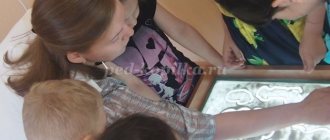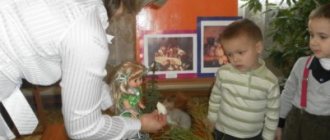Summary of a game lesson in kindergarten. Junior group
Game activity with children of the junior group “Mishka and his friends.”
Description of the material: I offer you a summary of a game lesson with children of the junior group “Bear and His Friends”. This material will be useful to educators and psychologists. The lesson is aimed at developing the basic new formations of social development in young children and will help teachers promote the successful adaptation of children to kindergarten. Goal: creating an emotionally comfortable atmosphere in the group, cohesion of the children's group. Objectives: - Develop self-regulation of students. — Formation of a positive emotional attitude, uniting a group of children Progress of the lesson Teacher-psychologist: Hello, guys! For some reason Mishka didn’t come to visit us. Maybe we can go visit him ourselves. What would you like to drive? Children: “By car, train.” The educational psychologist shows a flat model of a steam locomotive:
“Let's go by train.
I will be a train, and you stand one after another, so we have a train with carriages. Our train set off: Chug - chug, chug - chug The train rushes at full speed. Here we are. Look, there is a house, Mishka probably lives here. Let's knock." Children perform an imitation exercise - knocking with their fists. Mishka appears. Teacher-psychologist: “Say hello to Mishka. What a beautiful house you have. Tell Mishka why we came.” Children: “On a visit.” Bear: “I am very glad to have guests; I’ll show you everything.” Children: “Do you live alone in the house?” Bear: “No, not alone, but guess who lives in my house: He lives in the forest under a Christmas tree, He wears sharp needles. Teacher-psychologist: That's right, Hedgehog. Why are you, hedgehog, so prickly? Hedgehog: This is me just in case! Do you know who my neighbors are? Foxes, wolves and bears! Teacher-psychologist: Guys, do you know what the Hedgehog likes to eat? Milk. Let's give the Hedgehog some milk. (Children bring the saucer to the Hedgehog) Teacher-psychologist: Guys, what does Mishka like to eat? True Honey. Guys, only our Mishka is very sad for some reason. Bear why are you sad? (The little bear shows a small barrel of honey. And says that he has honey, but there is nothing to wash it down with). Teacher-psychologist: Children, let's give our little bear some tea, because he is our guest. (Invites children to the table).
What do you need to take to give Mishka tea?
Educational psychologist: takes one subject at a time, explains what it is called and what it is needed for. -This is a teapot, tea is poured into it. What color is our teapot? Where do we pour the tea? Here in this tea cup, which we put on the saucer. What color is the cup? Children's answers. - That's right blue! And what color is the saucer? Children's answers. -Yellow! Right. (educator-psychologist together with the children puts a cup on a saucer) (Children treat Mishka with tea) Educator-psychologist: Here we are, and we gave the little bear some tea. Our little bear became cheerful! Guys, Mishka says thank you for the children, he brought these cones as gifts. Let's play with the cones and Mishka. Finger game “Pine cones for a bear” The children walked through the forest (two cones lie on the rug, the children slap their palms on their knees) The children collected cones. (children take a cone in each hand) These are the cones (we spin the cones in front of us) We will give it to the bear! This is how the cones knock (we knock the cones on each other) All the kids are amused. These are the cones (we spin the cones in front of us) We will give it to the bear! We'll show the bear the cones (we hold out the cones to the bear) And then we'll hide them behind the back (we hide the cones behind the back) Look for the bear (we shake our shoulders) Where are our cones (the bear is looking for the cones.) And here they are! (children show) Admire the bear, these are the cones! (we spin the cones in front of us.) We put the cones in a bag and give them as a gift.
We recommend watching:
Game activity with children of the younger group. Summary of a game lesson with elements of logorhythmic exercises for children of the 2nd junior group. Summary of a game-lesson in the second junior group. Gift for mom Game - activity for children of primary preschool age
Similar articles:
Didactic game “The doll has a birthday”
Progress of the lesson
Cheerful music sounds.
Educator: I’m so glad to see everyone now, Let’s hug you all, Smile at each other and laugh together!
There is a knock on the door.
Educator: Who came to visit us, look who came!
He brings in a toy bear.
Educator: Who came to visit us?
Children, together with the teacher, look at the bear, say hello, discuss and attach parts of the bear’s body.
Educator: Mishka invites everyone to visit.
Where does Mishenka live? CHILDREN'S RESPONSES.
Educator: To come visit us, you need to walk along the path.
The song from the cartoon “Winnie the Pooh” sounds: “Who comes to visit in the morning...”
Walking on a ribbed board one after another
Children approach the pine cones scattered on the floor; there are two baskets nearby: a large one and a small one.
Educator: Mishka was walking through the forest, carrying pine cones in a basket. He stumbled and fell, immediately losing his cones. Who will help Mishka collect all the cones? We will collect the cones with you and sort them into baskets.
Children and the teacher examine the cones, note the difference in size, the teacher suggests putting the cones into baskets: large cones in a large basket, small cones in a small basket.
Game “put the pine cones into baskets”
Educator: How pleased the bear is, well, thank you, kids, My pine cones were laid out, the bear was very pleased. Now look at the baskets, first the big one, then the small one.
EYE GYMNASTICS ARE BEING CARRIED OUT.
Educator: The bear wants to play and stretch its paws. Let's play with the bear together, and repeat after the bear!
Physical training is being held
The bear is walking through the forest. walking in a flock A bear is walking through the forest. walking in a flock He puts the cones in his pocket. squats He puts the cones in his pocket. squats
He gained a lot of cones, he spread his arms to the sides. He didn’t lose a single one. turn their heads to the sides Oh yes bear, well done, clap their hands Our song is over! clap their hands
Educator: So you and I came to visit Mishka. Look, guys, Mishka wants to treat us to tea, he has placed colored saucers on the table. Let's help him. Place cups of the same color on saucers.
Didactic game “Find a cup the same color as the saucer”
(The teacher helps some children arrange mugs by color on saucers, clarifies and repeats with the children the color of the mug and the color of the saucer. Mishka thanks the children and offers them to drink tea.)
A didactic game “Washing your hands” is being held
We open the water tap - they finger it,
We are not afraid of water, - they stretch out their hands forward
We wash ourselves clean - imitate washing our hands and face
We smile at each other! - smile at each other
MAGAZINE Preschooler.RF
Summary of an integrated lesson with children 2-3 years old. Topic: “Visiting the bears.”Goal: to create conditions for children to acquire concepts about the differentiation of objects by size, to consolidate sensory ideas about color through didactic forms of educational activity.
Tasks:
- Consolidate knowledge about sensory standards of size ( “big” , “small” ) and color (primary colors);
- To interest children in an unusual way of drawing;
- Form cultural and hygienic skills;
- Develop speech;
- Cultivate neatness and a friendly attitude towards others.
Preliminary work: examination of towels, conversation “Fluffy towel” - about the purpose of the towel, didactic game for comparing sizes “Who has the longer towel” , construction game “Long and short towels” .
Methods and techniques:
Verbal (conversation, artistic expression, questions for children);
Problematic (problematic situations, problematic issues);
Visual (demonstration of towels);
Game (didactic exercise, finger play);
Practical (painting a figure with a roller);
Materials and equipment: a big bear toy, a small bear cub toy, two houses (large and small, decorations - “trees” and “flowers” , two towels (large red and small blue, handkerchief, baby sheet, white cardboard towel blanks - two sizes, blue and red gouache in trays, small rollers according to the number of children, treats for children.
Integration of educational areas:
Social and communicative development; Cognitive development; Speech development; Artistic and aesthetic development;
Physical development.
Progress of direct educational activities.
Children are included in a group with a teacher.
Form of organization: children follow the teacher in a flock and stand while talking.
Educator:
Children, are you in a good mood? (Yes). And I have a good one. Look how many guests have come to us, let's smile at them and give them a good mood - let's smile.
- Guys, today is an unusual day for us, we have guests in our group and today we ourselves will go into the forest to visit the bears.
The children follow the teacher into the forest. (An area in a group in which there are models of trees, flowers... Between the trees there are two houses. A large paw is visible on the side of the large house, and a small paw is visible on the side of the small house.) Together with the teacher, the children approach the houses in a flock.
Educator:
- What a beautiful forest, flowers, mushrooms, oh, what’s that among the trees? Yes, these are houses! I wonder who lives in them?
Guys, look, someone’s paws are visible from behind the houses. Whose paws do you think these are, who lives in the houses? Alena, who do you think lives in this house? (The teacher points to a large house) (Bear). Who lives in this house? (Points to a small house.) (bear cubs). Let's check if we named the animals correctly.
The teacher opens the curtains on the houses, and bear faces “peek out”
- Well done guys, they named it correctly, these are bears. Now let's look at the houses.
Styopa, what house is this? (Big).
What is this house like? (small).
- What kind of big house do you think the bear lives in? (Big). Why do you think? (He has a big muzzle and a big paw).
Vova, what kind of bears live in a small house? (small). Why? (They have small faces and small paws).
— Guys, do you want to get to know the bears better? (Yes)
The teacher takes the bears out of the houses.
Educator:
- Hello, bears. Why aren't you bears so funny? Guys, why are bears sad? (children's answers)
- Bears, what happened to you?
We washed our paws, but there was nothing to wipe them with. Help me please.
- Let's help the bears.
The teacher brings the children to the table on which they lie: a baby sheet, a handkerchief and a towel.
Educator:
Nastya, show me how you can wipe the bears’ paws? (Nastya takes a towel)
- That's right, you can wipe your paws with a towel.
- Alena, what do they wipe with a handkerchief? (Nose).
- Stepan, what is this? (Bed sheet).
- And what is it for? (put it on the bed)
The teacher shows the children two towels: large and small.
— Guys, I have towels for our bears. What is this? (Big) And this? (small)
What do you think, which bear needs a large towel? (To the big one). What about a small towel? (To the little bears).
- Guys, let's tell the bears what color their towels are. Gleb, what color is this towel? (red). Nastya, what color is this towel? (Blue). Well done!
But guys, look, not all the bears have a towel. Let's give these bears some towels too. Look, I have these boring towels (the teacher shows undecorated mock-ups of towels).
Let's decorate them and give them to the bears. We will decorate the towels with stamps. It needs to be dipped in paint and applied to the towel like this. (Teacher demonstration).
But for you to succeed, you need to warm up your fingers.
Let's play..
Physical exercise.
Let's wash the towels, rub them hard, like this, like that, rub them really hard.
And then, and then we’ll wring out the towels, like this, like this we’ll wring out the towels!
And now, now let's shake the towels, like this, like this, shake the towels!
I imitate pointing actions, and the children repeat the movements.
Productive activity.
The teacher invites the children to go to the table on which there are prepared towels). (After coloring, children wipe their hands with paper napkins.)
Children decorate their towels, place them on a tray and give them to the bears.
Result: Guys, who did you meet today? How tall are our bears? What did you do? (children's answers). Well done! You did a very good job today!
And the bears have prepared treats for you too. Bear candies.
| Next > |




